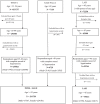Gender difference in prevalence of hypertension among Indians across various age-groups: a report from multiple nationally representative samples
- PMID: 35948916
- PMCID: PMC9364494
- DOI: 10.1186/s12889-022-13949-5
Gender difference in prevalence of hypertension among Indians across various age-groups: a report from multiple nationally representative samples
Abstract
Background: Prevalence of hypertension increases with age, but there is a general perception in India that women are less affected at every stage of life, although empiric evidence hardly exists regarding gender difference in hypertension in Indians of different ages. Therefore, we aimed to examine the gender difference in hypertension among Indians across various age-groups; and the contribution of variation in body mass index (BMI) to this difference.
Methods: Data were analysed after combining National Family Health Survey 4 (n = 294,584 aged 35-49 years) and Study of Ageing and Health wave 2 (n = 7118 aged 50 + years) datasets (NFHS-SAGE). Longitudinal Ageing Study of India (LASI) dataset (n = 65,900 aged > 45years) was analysed to replicate the results. Hypertension was defined if systolic and diastolic blood pressure was > 89 and/or > 139 respectively and/or if there was a history of anti-hypertensive medication. Descriptive summaries were tabulated and plotted to examine the gender difference in hypertension in various age-groups (35-39,40-44, 45-49, 50-54, 55-59, 60-64, 65-69, ≥ 70). Odds Ratios (ORs) from logistic regression models estimated the age gradient of hypertension and their male-female difference, adjusted for Body Mass Index (BMI).
Results: Males had a higher prevalence of hypertension up to 50 years; after that, females had higher rates. The estimates of age gradient, expressed as ORs, were 1.02 (1.02, 1.02) in males versus 1.05(1.05, 1.06) in females (p < 0.001) in NFHS-SAGE and 1.01(1.01, 1.02) in males versus 1.04(1.03, 1.04)in females (p < 0.001) in LASI;these differences marginally changed after adjustment with BMI.
Conclusion: This is perhaps the first study to comprehensively demonstrate that cardio-metabolic risk in Indian females surpasses males after 50 years of age, "busting the myth" that Indian females are always at much lower risk than males; and this evidence should inform the Indian healthcare system to prioritise older women for screening and treatment of hypertension.
Keywords: Age-groups; BMI; Gender; Hypertension; India; LASI; NFHS; SAGE.
© 2022. The Author(s).
Conflict of interest statement
The authors declare that there is no competing interest.
Figures
Similar articles
-
Social epidemiology of excess weight and central adiposity in older Indians: analysis of Study on global AGEing and adult health (SAGE).BMJ Open. 2015 Nov 26;5(11):e008608. doi: 10.1136/bmjopen-2015-008608. BMJ Open. 2015. PMID: 26610757 Free PMC article.
-
Association Between Abdominal Obesity, Body Mass Index, and Hypertension in India: Evidence From a Large Nationally Representative Data.J Clin Hypertens (Greenwich). 2025 Mar;27(3):e70034. doi: 10.1111/jch.70034. J Clin Hypertens (Greenwich). 2025. PMID: 40101017 Free PMC article.
-
Sex-specific prevalence, awareness, treatment and control of hypertension in adults in India: a study for developing sex-specific public policy from the longitudinal ageing study in India (LASI) data 2017-2018.J Health Popul Nutr. 2023 Aug 25;42(1):85. doi: 10.1186/s41043-023-00404-3. J Health Popul Nutr. 2023. PMID: 37626344 Free PMC article.
-
What causes concordance of hypertension between spouses in India? Identifying a critical knowledge gap from a nationally representative cross-sectional sample of 63,020 couples aged 15 + years.BMC Public Health. 2023 Jul 27;23(1):1434. doi: 10.1186/s12889-023-16379-z. BMC Public Health. 2023. PMID: 37501082 Free PMC article.
-
Prevalence and associated risk factors of hypertension among persons aged 15-49 in India: a cross-sectional study.BMJ Open. 2019 Dec 16;9(12):e029714. doi: 10.1136/bmjopen-2019-029714. BMJ Open. 2019. PMID: 31848161 Free PMC article.
Cited by
-
Prevalence of Hypertension and Associated Factors among Residents Aged ≥18 Years in Ganzhou, China: A Cross-Sectional Study.Int J Hypertens. 2023 Oct 5;2023:5486139. doi: 10.1155/2023/5486139. eCollection 2023. Int J Hypertens. 2023. PMID: 37841509 Free PMC article.
-
Variations in the hypertension care cascade across districts and the factors influencing it among Indian adults: findings from the National Family Health Survey -5.J Hum Hypertens. 2025 Aug;39(8):585-594. doi: 10.1038/s41371-025-01039-z. Epub 2025 Jul 9. J Hum Hypertens. 2025. PMID: 40634518
-
National and Regional Trends in the Prevalence of Hypertension in South Korea Amid the Pandemic, 2009-2022: Nationwide Study of Over 3 Million Individuals.JMIR Public Health Surveill. 2024 Jul 30;10:e51891. doi: 10.2196/51891. JMIR Public Health Surveill. 2024. PMID: 39078683 Free PMC article.
-
Prevalence and determinants of prehypertension (elevated blood pressure or high normal BP) according to different classifications in India during 2015-2021: Evidence from the large national surveys.PLoS One. 2025 Jun 11;20(6):e0325437. doi: 10.1371/journal.pone.0325437. eCollection 2025. PLoS One. 2025. PMID: 40498809 Free PMC article.
-
Knowledge, Awareness, and Determinants of Medication Adherence in Hypertensive Patients: A Hospital-Based Cross-sectional Study in North India.J Pharm Bioallied Sci. 2024 Feb;16(Suppl 1):S118-S121. doi: 10.4103/jpbs.jpbs_406_23. Epub 2024 Feb 29. J Pharm Bioallied Sci. 2024. PMID: 38595606 Free PMC article.
References
-
- Noncommunicable diseases: Mortality [Internet]. [cited 2022 Apr 7]. Available from: https://www.who.int/data/gho/data/themes/topics/topic-details/GHO/ncd-mo...
MeSH terms
LinkOut - more resources
Full Text Sources
Medical



